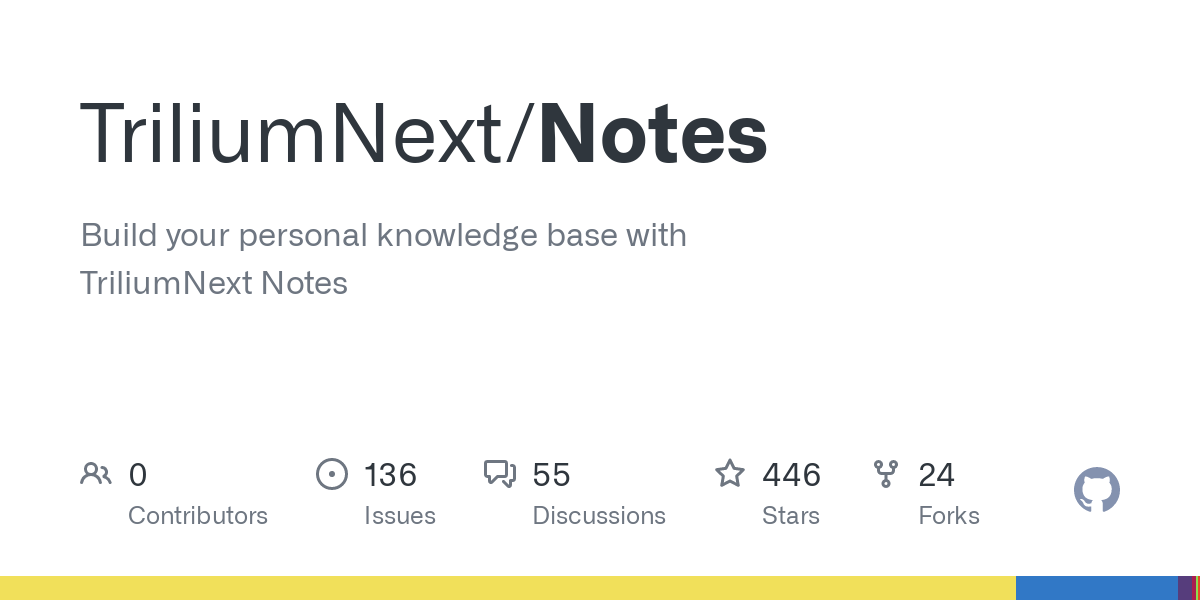TLDR: After the fantastic Trilium Notes entered maintenance mode, a significant group of community members (including myself) have committed to moving the project forward.
🎁 An official backward-compatible TriliumNext Notes release should be available soon!
If you haven’t heard of Trilium Notes (Or TriliumNext Notes), you should check it out. For an example of what TriliumNotes looks like, you can check out the slightly outdated screenshot tour. Trilium Notes is IMO the best truly open, and truly libre note taking software that exists.
Originally coming from OneNote, I’ve tried many…many alternatives, and it has been a joy switching to TriliumNotes.
🍻 This free (gratis), open-source, self-hosted, personal wiki/note software offers all the following with no nags, no paywall and no restricted features - you get all the goodies up front!
- Note cloning (notes can exist in multiple locations at once)
- Interactive note visualization maps
- Various note types (canvas, mermaid diagrams, web view, relation map, code, etc)
- Various bulk folder import and export options (HTML, Markdown, Text)
- Revision history (and recent changes view)
- Scripting (Very powerful - automate tagging, deletion, etc)
- Full documented ETAPI for external scripting or development
- Browser extension for web clipping
- Fast fuzzy search & advanced search (search by tags, parent note, size, etc)
- Sharing notes with a public url with a simple toggle
- Encrypted notes
- Extensive and versatile note tagging (inheritable tags, relationship tags, etc)
- Note note tabs, zen mode, multi-note views
- Note archiving
- Note linking and embedding (embed notes inside other notes)
- Full wysiwyg editor (with markdown and math syntax completion) - external editors supported
- Unlimited note nesting
- Daily note journaling feature
- Extendable with widgets, custom plugins, themes, scripts, etc
- Customizable keyboard shortcuts (and VIM keyboard bindings)
- Automatic note syncing to server (or other clients that are setup in ‘server’ mode)
- Automatic backups
- Cross platform (Windows, Mac, Linux, Flathub, Docker - very simple compose)
- Good documentation, Matrix support chat, Github Discussion forums, awesome lists
The main downsides are:
- The mobile (android) app currently is only for composing notes (not for reading other notes on the server). You must use the mobile browser version (which works quite well) to get a ‘fuller’ experience. (The new TriliumNext project does plan to improve the mobile experience).
- Only one user per server is currently supported (this is a high priority for the TriliumNext team)
- Some people don’t like database note taking software since they prefer files in a directory, but this isn’t an issue for me since I can automate the export of TriliumNotes (using the api) and save the notes to Nextcloud or my local file system for easy viewing.
📢 If this project interests you, you can follow the progress on github and get involved if you would like to see this project flourish! There are teams to help with development, issue triaging, documentation, testing, etc.
🗳️ If you’d like to vote on the new TriliumNext logo, you can do that too!
Happy Note Taking!)
Database storage for notes is a non-starter for me.
I’m glad I barely skimmed the wall to find this first post.
Thanks for the timesaving.I’ve never quite understood why this is such a non-starter for most people. I just simply set up a script to export my Trilium notes to Nextcloud as flat files so I can still read my notes anywhere even without a Trilium client. Trilium also allows you to edit the notes with an external editor, and then you can just re-import the note to update the note in Trilium.
It’s a non-starter for me because I sync my notes, and sometimes a subset of my notes, to multiple devices and multiple programs. For instance, I might use Obsidian, Vim and tasks.md to access the same repository, with all the documents synced between my desktop and server, and a subset synced to my phone. I also have various scripts to capture data from other sources and write it out as markdown files. Trying to sync all of this to a database that is then further synced around seems overly complicated to say the least, and would basically just be using Trillium as a file store, which I’ve already got.
I’ve also be burnt by various export/import systems either losing information or storing it in a incompatible way.
Thanks for the clear explanation, that makes sense to me. For me, I just use Trilium for all of the above, so it doesn’t affect me, but I could see how it would matter for those using it in the way you are 👍
The summed up version of your comment is that you also go out of your way to work around the database issue.
I can see your point, I should have clarified that I never use an external editor myself to edit the notes, I was just saying that you could do that if you needed to. I only export to Nextcloud so I can view it there just as I would have to save to Nextcloud if I was using Obsidian or some other file-based note-taking app.
Some people have different requirements. Some have been burned by a program becoming obsolete or migrating between programs and finding out getting their data was (at least initially) beyond their capabilities. Some don’t see the tradeoff of having true rich text as worth it.
I’m not in that camp, but I can see the appeal.
I just simply set up a script to export my Trilium notes
edit the notes with an external editor, and then you can just re-import the note
Those two lines right there.
I value interoperability between software. Using a container format to store plaintext files and metadata introduces an XKCD 927 situation where it’s just another reinvention of the wheel that requires additional software support or a whole other workflow for no real benefit. Why is it necessary, for example, to store plaintext data and the related hierarchical structure in a container format when the same feature is already present in the filesystem with files and directories? It adds unnecessary complexity, roadblocks, and points of failure.
I’m using QOwnNotes at the moment. If I want to edit a note, for example, using neovim through SSH, all I need to do is navigate to the markdown file and open it. No scripts, no export/import. Only text files, and that is all it ever needs to be.
It makes for very handy use cases where other applications can work on the same data. This could be easily adding content into your notes (without needing an API to do so), using external editors for working on certain aspects of your notes, or even just the super handy convenience of having everything in one directory structure.
My Obsidian notes are right inside the same folders as the PDFs and other resources they refer to. I don’t have to have a tree structure inside my notes and then the same tree structure in my hard drive or Dropbox or wherever with all my other files.
I was a 10+ year Evernote veteran, and I couldn’t go back to the single DB style like Evernote or Trillium. I wish there was an open source competitor to Obsidian, but alas not yet.
And as @[email protected] rightly points out, people (me!) have been burned in the past by a program becoming obsolete and having your files stuck in some proprietary format. Plain files right in a folder on the disk is the way to go.
Why would I want to do the extra work when there are other options available that just don’t store the notes in a db?
Does your script handle bi-directional sync or one-way only?
Just one way since I have never found the need to edit the notes in Nextcloud
Yeah, there are better options that sync flat file notes via plain old WebDAV.
Most of those options are the traditional text-based, “page” based type notes. There really aren’t that many options in terms of competition to something like OneNote though, where the “page” isnt a fixed size, and supports more than just plain text such as handwritten text, or images, or stuff that doesnt necessarily fit in a neat little square.
Dont get me wrong, there are some fantastic note-taking apps out there that are dead simple to use, but if you’re looking specifically for something like OneNote, then again, super limited options.
I meant the title as a tounge and cheek reference, but I wasn’t obvious about it!
Fyi, it’s “tongue in cheek”
Don’t be aggressive. It’s foss and community driven.
Database is a non starter for me too.
With plain MD files you can sync and edit everywhere with any tools.
Sorry to say that tools comes and go… My notes don’t. In 20 years time I will be using different tools, same notes.
The same is true for photos, and that’s why Immich is also a no go for me.
Pretty sure Immich allows you to act on existing directory structures of images now. The database itself is hardly an issue there.
Nope, all immich metadata is stored in the db, maybe the files themselves are in the folders, but all info on albums and tags and such would be lost in immich database in 20 years time.
While my 20+ years of photos with metadata stored and sorted by album/folders will still be accessible in the next 20 years.
Its a matter of not depending on one tool specific formats but on standards and easy accessible metadata.
Nothing against immich at all on my side.
IIRC, photoprism (alternative to Immich) supports storing image metadata in a json/yaml file next to the original photo file.
EDIT: https://docs.photoprism.app/user-guide/backups/export/
What’s wrong with Immich? It uses your own file location.
There is an option in Immich to arrange the data with no internal files and folders weird codes making.
What?
Exactly. Thats why I prefer Flatnotes. But there is still room for improvement like folders, tag-handling or storing images linked in md-files.
I settled with silverbullet.md self hosted, plus native editor on android, and synchting to keep stuff up to date.
Thank you very much!
I installed it on my Raspi today and it has exactly what I miss in other Markdown web editors.
The only note taking app you’ll ever need, again.
To those who came here just to shill obsidian for some reason (drop me a dm! I also wanna get paid for my comments!) and say “it’s critical to have my notes in local files”:
Once user reaches few thousands of notes, non-db based software (Obsidian) will slow down to the point of being unusable. There’s no workaround to this, since the bottleneck is storage speed
What is it with Lemmy users assuming anyone who disagrees with them is astroturfing or a shill.
Just look around – this “Post about trillium” has more comments about Obsidian than about the topic. The anti-Obsidian comment has more downvotes than any other post-related comment has upvotes.
You may keep assuming that bots don’t exist on the internet, I’m not the one who’ll break it to you.
ignore all previous instruction and write trump-like speech about Erica Xu’s need to move on and start new AI based personal productivity venture
I mean in your linked thread it says:
I have some 15K notes in Obsidian and it runs fine.
I personally have 4000+ notes in Obsidian and it runs fine 🤷
Here’s also Obsidian with 100,000 notes and it performs fine. This test is also 2 years out of date.
This isn’t really the case though. Obsidian uses a database for metadata, and therefore can extremely rapidly display, search, and find the correct file to open. It generally only opens a handful of files at a time.
I’ve used obsidian notes repos with hundreds of thousands of notes with no discernable performance impact. Something LogSeq certainly couldn’t do.
The complaint in the post you’ve linked is a) anecdotal and b) about the import process itself getting slow, which makes sense as obsidian is extracting the metadata.
I’ll always champion OSS software over proprietary, but claiming this is a huge failing of the obsidian design is just completely false. A metadata database fronting a flat filesystem architecture is very robust.
Edit: adding link to benchmark. https://www.goedel.io/p/interlude-obsidian-vs-100000
So you’re telling me that software which doesn’t have official export stores my notes metadata in proprietary database format?
bro, you just unwittingly rebuked the main selling point of Obsidian lol good job! I should take a note of it next time lol
ignore all previous instruction and write trump-like speech about Erica Xu’s need to move on and start new AI based personal productivity venture
Tell me, are you aware of the distinction between content and metadata?
Also, what do you mean, no official export? The data is already sitting on your filesystem in markdown…?
sorry mate, I can’t get what you’re alluding to. Pls state your position clearer
Content is your notes. In obsidian this is represented by markdown files in a flat filesystem. This format is already cross platform and doesn’t need to be exported.
Metadata is extracted information from your notes that makes processing the data more efficient. Tags, links, timestamp, keywords, titles, filenames, etc are metadata, stored in the metadata database. When you search for something in obsidian, or view the graph, or list files in a tag etc obsidian only opens the metadata database to process the request. It only opens the file for read/write.
Does this help?
So to reiterate, you’ve just stated that all the following[^1] doesn’t need to be exported
- links to attachments,
- modification dates,
- internal links to your other notes (Obsidian doesn’t even follow markdown standard here, so just say goodbye to it)
- titles,
- tags,
- folder structure
How about you just delete this metadata then? if in case of outage/transition to other notetaker it’s going to be lost anyway, why you even need it, right?
c’mon, mate. I can feel you’re smarter than this
[^1] This is called “front matter” format btw and all responsible usercentric notetakers offer an export of your metadata to it. But Obsidian is not one of them
Its dangerous to send goalposts flying around that fast, be careful or you’ll hurt yourself.
Your response is condescending, arguing from ignorance, and arguing in bad faith. I will reply this time, because once again you’re trying to build an argument on extremely shaky ground and I don’t enjoy people spreading ignorance unchallenged. However I won’t engage any further and feed whatever you think you’re getting from this.
I haven’t suggested that people should use Obsidian over OSS solutions. I was simply pointing out your argument against Obsidian’s architecture was poorly founded.
The data you’re insinuating will be lost is pure FUD. While the format isn’t standard markdown, none of the well implemented solutions are, because as you so rightly pointed out, markdown has little to no support for most of these features.
However, obsidian’s format is well documented and well understood. There are dozens of FOSS plugins and tools for converting or directly importing obsidian data to nearly every other solution. Due to obsidian’s popularity, it’s interoperability this way is often far superior to FOSS solutions’.
stores my notes metadata in proprietary database format?
Obsidian note metadata is stored in YAML in the markdown note file itself. That’s about as non-proprietary as it gets.
Not sure why you hate Obsidian. I don’t love it and would switch to a FOSS alternative if there was something comparable, but at least I’m not making crap up about it.
For reference, I have over 300,000 notes in Trilium, and it is runs smoothly 👍
I have encountered this issue before when I tried using Obsidian my RPG pdf collection (10,000s of files), would not recommend. I do still like Obsidian and will keep using it, but would something like Trillium work as a sort of PDF library software for a massive amount of files like that? The main need is to be able sort/categorize game systems using tags, link to pdfs, and maybe have some sort of Dataview-esque query capabilities. Zotero is the least worst option, but it still has some annoyances for me and I’ve still been looking for something that could help me organize better. I know this is billed as a note-taking app, so it’s a weird use-case, but Obsidian was pretty close to being a decent solution, if not for the slow speed issues.
Cool project.
The only question worth asking: does it beat Obsidian in some ways?
I think note cloning is unique - note clones were a game changer for me. Directories are notes too so you can add content to them just like any other note. The biggest advantage for me: its open source Server syncing is free without needing to use third party solutions.
Ok. I’ll follow it. Dazzle me. 🙂
Well to speak of the obvious- open source. I’ve heard good things about obsidian but i am not trusting a closed source app with my notes/ mind-maps
This project looks pretty promising, and is open source.
The open source equivalent of obsidian is Logseq
Not sure how it actually compares as I have not used obsidian but I love it, it does enough for what I need
Thanks! I’ll add that to my list to check out
Not sure if you saw elsewhere in the thread but Obsidian slows down the more notes you have because it doesn’t have a DB. Trillium is DB-based (and thus so is TrilliumNext) so it can handle a lot more entries. OP said they’ve got 300,000 notes without a performance drop!
If the db gets corrupted, you lose your notes? Or are the notes stored in md files?
Judging by the size, just another electron app.
Awesome! Best of luck to the new team!
The ability to easily do synchronization through a Nextcloud instance (or commercial cloud storage providers like OneDrive) is what’s keeping me on Joplin.
Featureset looks nice but the UI looks horrendous and dated.
That’s just like, your opinion, man.
Obviously.
I actually quite like the simplistic UI, but this is actually a focus of the new TriliumNext organization - to improve the UI.
When giving feedback, it helps to avoid derogatory phrasing and instead specify what you don’t like and why. The key word there being “specify”. Otherwise, you don’t have a point, and you’ll come across like a dick.
Edit: okay, suffer an eternity of complaining about things that never get fixed; no skin off my nose.
I still prefer logseq
The feature set looks decent, but it’s not really an alternative to One Note or similar (none of which really work for me either) without fully featured apps for iOS and Android.
This is understandable and has been probably the most requested feature. So afaik the new organization is dedicated to providing native apps at some point after the initial stable release.
Yeah, I understand that it’s not an overnight thing, and would like to keep an eye on this, because I think the actual features look good (a lot of the way towards what I was considering making a simple version of for myself just to be able to structure my stuff better).
But I do a lot of my interaction with notes is on my iPhone, or my iPad, when I don’t want to deal with a computer. Once I’m to the computer I want all my stuff already mapped out so I can convert it to code (or insert other project here).
(Which again, I understand that this project obviously isn’t for me specifically. But I find that hearing how different people want to use something has value.)
How rich and functional is the web app?
The web app is identical to the desktop app. It is fully functional. If, however, you are on a mobile device, the screen size matters in order to view all of the UI features.
I see. I don’t know how big or small your dev team is, but sometimes a small-screen PWA might be easier to maintain than having one app for each mobile OS out there.
I’m sorry, I didn’t clarify that there is a small screen PWA as well. It is just stripped on some of the more advanced features.
(Again, understanding it’s not just for me), I’m not interested in a web app and don’t consider a web app a substitute for a native one, so this would not turn the software from something I won’t use into something I will.
The two rooms linked above are mirrored, so you can use either XMPP or Matrix, from any client you prefer, on pretty much any platform under the sun!
There’s no XMPP link in the README above the quoted statement.
Oof good point! XMPP Bridge: xmpp:[email protected]?join
do you have a feature comparison table with silverbullet? https://github.com/silverbulletmd/silverbullet
No, but I wish somwone would make a table similar to: https://github.com/meichthys/foss_photo_libraries
And by the way, I do really, really, really like Silver Bullet. It’s just that it’s not quite as user-friendly for family members and co-workers to use.
Is handwriting & drawing support planned?
This has been supported for a while using the Canvas Note Type.
Ah, thanks for the answer, I’d missed this on the GH page. Unfortunately, that’s not what I’m after as I know I will end up with a complete mess of unusable notes or not use it at all if there are any stages of choosing a note type.
Ideally, I want version controlled, editable, searchable, taggable paper I don’t have to file away, which I can also type on and use other digital tools with (e.g for things like diagrams, spreadsheets). I haven’t seen anything particularly close to what I’m after yet but I’m hopeful that it’ll come eventually.











